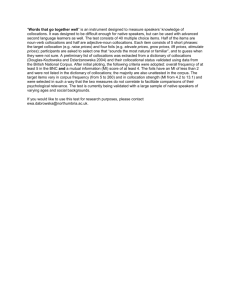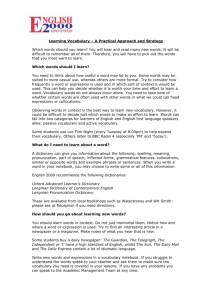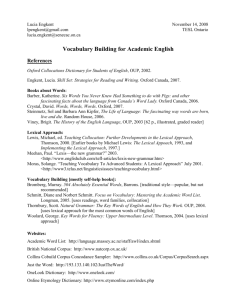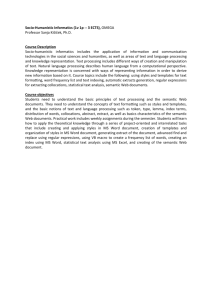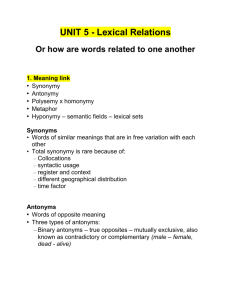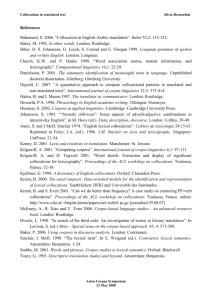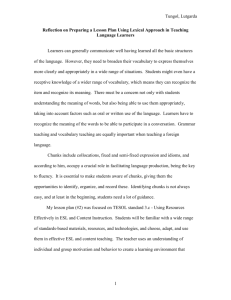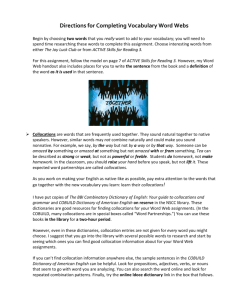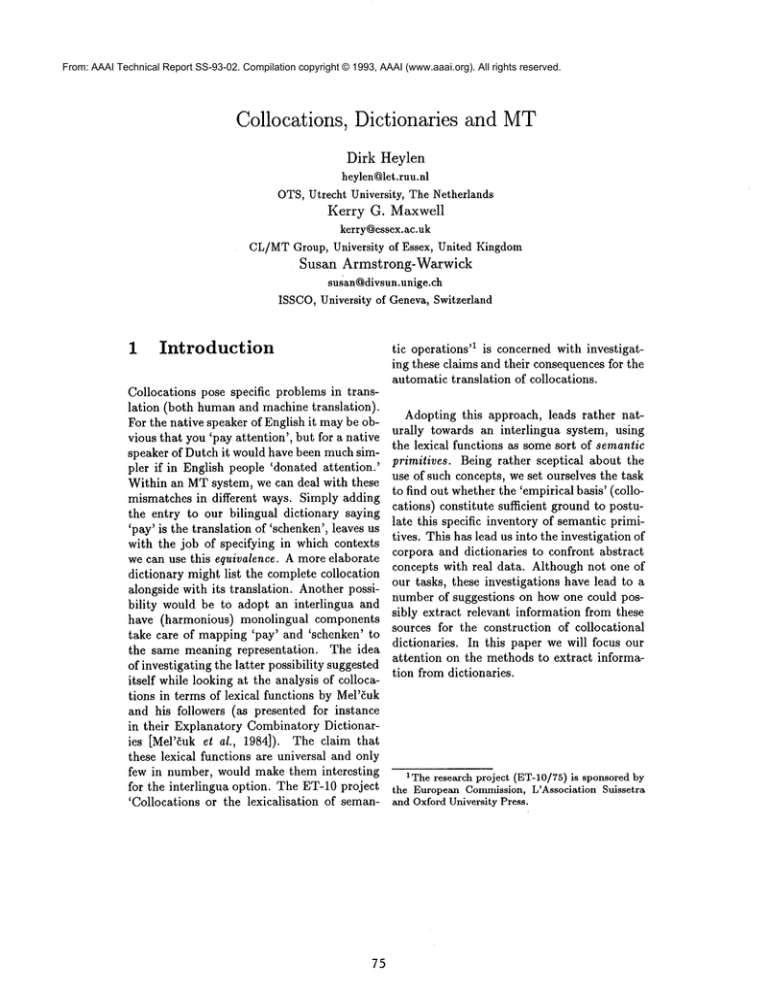
From: AAAI Technical Report SS-93-02. Compilation copyright © 1993, AAAI (www.aaai.org). All rights reserved.
Collocations, Dictionaries and MT
Dirk Heylen
heylen@let.ruu.nl
OTS,Utrecht University, The Netherlands
Kerry G. Maxwell
kerry@essex.ac.uk
CL/MTGroup, University of Essex, United Kingdom
Susan Armstrong-Warwick
susan~divsun.unige.ch
ISSCO,University of Geneva, Switzerland
1
Introduction
Collocations pose specific problems in translation (both human and machine translation).
For the native speaker of English it maybe obvious that you ’pay attention’, but for a native
speaker of Dutch it would have been muchsimpler if in English people ’donated attention.’
Within an MTsystem, we can deal with these
mismatches in different ways. Simply adding
the entry to our bilingual dictionary saying
’pay’ is the translation of ’schenken’, leaves us
with the job of specifying in which contexts
we can use this equivalence. A more elaborate
dictionary might list the complete collocation
alongside with its translation. Another possibility would be to adopt an interlingua and
have (harmonious) monolingual components
take care of mapping ’pay’ and ’schenken’ to
the same meaning representation.
The idea
of investigating the latter possibility suggested
itself while looking at the analysis of collocations in terms of lexical functions by Mel’5uk
and his followers (as presented for instance
in their Explanatory Combinatory Dictionaries [Mel’~uk et al., 1984]). The claim that
these lexical functions are universal and only
few in number, would make them interesting
for the interlingua option. The ET-10 project
’Collocations or the lexicalisation of seman-
75
tic operations ’1 is concerned with investigating these claims and their consequences for the
automatic translation of collocations.
Adopting this approach, leads rather naturally towards an interlingua system, using
the lexical functions as some sort of semantic
primitives. Being rather sceptical about the
use of such concepts, we set ourselves the task
to find out whether the ’empirical basis’ (collocations) constitute sufficient ground to postulate this specific inventory of semantic primitives. This has lead us into the investigation of
corpora and dictionaries to confront abstract
concepts with real data. Although not one of
our tasks, these investigations have lead to a
number of suggestions on how one could possibly extract relevant information from these
sources for the construction of collocational
dictionaries. In this paper we will focus our
attention on the methods to extract information from dictionaries.
1Theresearch project (ET-10/75)is sponsored
the EuropeanCommission,L’Association Suissetra
and OxfordUniversity Press.
2
Collocations
Semantics
and
tion represents some meaningful operation
which yields the lexeme (collocate) that typically combines with the argument (head of
Previous work ([Church and Hanks, 1989], the collocation) of the function to express
[Smadja, to appear] and earlier work) on the the meaning of the function. Simplifying,
acquisition of collocational information has Magn -- meaning something like "intense"
concentrated on the extraction of collocations -- is expressed by heavy when said of smoker.
from corpora based on some statistical
mea- More complex functions can be constructed by
(1) combining functions; (2) adding different
sures. Programs such as XTRACT([Smadja,
kinds
of sub- and superscripts. The following
to appear]) are able to select an interesting colexamples
illustrate this.
lection of potential ’collocations’. The notion
of collocation that lies behind these investiga"IncepFuncl(vent) = se lever
tions is that of ’recurrent combination’. The
FinFunel(vent) = se calmer
notion we are investigating however, is differMagn[,con,equence,,] ( maladie) = sdrieuse
ent as it only concerns collocations in which we
The last example, clearly illustrates that the
can clearly distinguish a collocate which has a basic lexical functions are in need of some
’general’ or ’non-literal’
reading. The mode refinement. The semantic component of the
of defining ’collocations’ in our approach is argument which the intensifier relates to is
different from the performance or probability
explicitly
mentioned in the subscript.
In
approach. Instead, we are interested
in a [Heylen, 1992] we have suggested some ways
linguistic or lexicographic way of defining col- to make lexical functions sensitive to the selocations and more particularly the semantics mantic structure of the arguments, by incorpoof collocations. The first approach leads to rating for instance qualia information ([Pustethe notion of collocations we have termed p- jovsky, 1991]) in the semantic representation
collocation elsewhere ([Sloksma el at., 1992]), of nouns. Notice also that lexical functions
whereas the second modeleads to a set of l- go with the ideology that the association be2.
collocations
tween heads and collocates is to be specified
But what are the semantic aspects of col- lexically, because it is unpredictable. They do
locations we are interested in exactly? In the not consider any kind of (sub)regularities that
analysis by Mel’~ukof the kind of collocations may exist.
we are interested in (mainly adjective-noun
One of the aims of the project is to evaluate
combinations and light verb constructions),
Mel’~uk’s system of lexical functions. Among
construction such as heavy smoker is analyzed the questions we are interested in are the folby means of a lexical function Magn. In the lowing.
Explanatory Combinatory Dictionary z the en¯ Cancollocations 5 be associated with lexical
try for smoker contains information of the folfunctions as the theory assumes they can?
lowing kind.
¯ In what wayscan the notion of lexical function be refined?
Magn(smoker) = heavy
- Can we makethem sensitive to the seMel’~uk claims that we need about 50 of
mantic structure of their arguments?
these ’universal’ functions to describe the se-Can we make precise the paramemantics of most collocations 4. A lexical functers that differentiate the possible values of a function? For instance, we
Sin fact, it turns out that a further distinction
might want to differentiate between
should be made between the lexlcographlc and the llnsharp/wide turns, or for instance beguistic approach to collocations.
Wewill not go into
further details here.
tween certain "degrees of intensity"
3The dictionary that goes with the Meaning Text
when we are considering Magnetc.
Model.
4 Understood as l-collocations.
5At least a definable subset.
76
¯ Canwe find someregular patterns in the formationof collocations?
From a methodological point of view, it
is important to be able to go beyond possibly deceiving intuitions.
Wetherefore have
to provide for more reliable ways to get at
our data. Listings of collocations as provided
by XTRACT-Iikeprograms, are useful as filters on the data to consider. But as we are
concerned predominantly with semantic issues
whenevaluating the lexical function approach,
we need programs that can be made sensitive
to the meaning of the expressions considered.
To get at a more interesting collection of data,
we have looked for material from which certain aspects of meaning can be read off in
one way or another. Of course, dictionaries
are one source which deals directly with the
representation of meaning. But it is not the
explicit encoding which is most interesting to
look at. Indeed, it turns out that most dictionaries do not provide the kind of information
we are interested in directly 6. It is the less obvious structure of the dictionary entry which
gives rise to interesting pieces of information.
In the following sections we list a number of
ways we can use dictionaries to collect data on
the semantic issues we are concerned with.
3
Monolingual
ies
Dictionar-
organisation we investigate the lexicographic
conventions adopted and the overall rationale
behind the organization of the dictionary.
3.1
Lexicographic
Conventions
Of course in producing the dictionary a set of
rules and general practices have to be developed in order to ensure internal consistency.
In other words, where there is perceived flexibility in description/methodology, the lexicographer may adopt a certain path simply because this corresponds to a convention among
those established for the construction of the
particular dictionary. Someof these conventions will ultimately reflect linguistic facts,
whilst others will be purely arbitrary. Such
conventions often remain implicit in the nature of the resulting dictionary and are never
directly explained, whilst others mayoccasionally be alluded to in the frontmatter of the
dictionary. For instance, in the frontmatter of
OALD3
we find an explanation of the listing of
definitions and meanings of words, where the
user is told that:"...definitions are listed in order of
meanings from the most commonor
most simple to the most rare or most
complicated" (p.xiv)
Such a convention may seem arbitrary 7 in the
sense that it seems to rest on the intuitions
of individual lexicographers, but what might
In this section we investigate how far we it imply in our quest for information on the
can gather information about collocations and semantics of collocates? Of course we should
collocational behaviour by scrutinizing the note that "rare" and "complicated" and "simformats of learner’s dictionaries.
Wefo- ple" and "common" are not always mutually
cus our attention
on the Oxford Advanced prevailing characteristics, ie: a commonmeanLearner’s Dictionary, third edition [Hornby, ing is not necesarily simple nor a rare meaning
for our
1974] (henceforth OALD3),but we would ex- complicated. A useful interpretation
pect these observations to have more general purposes is perhaps that "rare/complicated"
validity. Weexamine the dictionary on both corresponds to "figurative/nonstandard"
and
a macro- and microlexicographical level, ie:
accordingly "simple/common" corresponds to
in addition to looking at the details of entry
7However
we should point out that lexicographers
6First of all, weare interestedin ~abstract’seman- workto a set of explicit compilerinstructions which
tic concept.Secondly,lexicographictradition treats a maydeterminethe most arbitrary decisions. Further,
ntunberof different constructionsin the samewaythey lexicographersshouldbe highly skilled withrich intuitions about the languageunderdescription.
treat the kindof collocationsweare interested in.
77
"standard" or "regular", so that in the case
of entries for adjectives which form collocates,
the definitions which constitute the secondary,
or later explanations of meaning (ie: those
that occur "further down" the entry) will be
the more significant ones for our interests.
In the discussion of the representation of idiom structures, we are told that:"..to find an idiom, look for it in the
entry for the most important word
in the phrase or sentence (usually
noun, verb or adjective)." (p. xvi)
This means for instance that the idiom pick
holes in can be found in the entry for hole and
that the idiom get hold of the wrong end of the
stick can be found under the entry for stick. Of
course, most "important" merely corresponds
to what is perceived to be most salient, though
it may be that observation of what are considered to be the most salient elements of idioms
may lead us to intuitions about where the semantic load lies in such structures.
In sum, even though the conventions underlying the description of such lexical phenomena mayappear arbitrary at first sight, it may
be that somereveal general linguistic insights,
explain omissions, or provide pointers to the
information in an entry that we are most interested in. Weshould at least be aware of
them as we embark upon extraction of information, automatic or otherwise.
3.2
User
Needs
A natural consequence of the learner orientation of the OALD3is that the dictionary
weighs heavily on explanatory and exemplary
data, generally residing in specific example
fields, and, as will be shownin later sections,
this field of information proves extremely fruitful in the collection of collocational data. The
frontmatter details several reasons for the extensive inclusion of example fields (p. xvii),
the key one being of course their general role
in reinforcing the explanation of the meaning
of (groups of) words. Also worthy of note
the aim of illustrating
words and multiword
78
forms in different sentence patterns s, and the
indication of the "style" or "context" in which
the word or phrase is usually used. The latter
means that example fields often:"...include words or sorts of words
that the headword is usually used
with..,
for example at sensational (2) there is a sensational
writer/newspaper." (p. xviii)
Such examples illustrate
the potential for
stumbling across example collocations, as well
as hints about lexical selection, which mayin
turn reveal issues in the semantics of collocational structures (cf: section 3.3.1).
To summarize - an integral aspect of the
rationale behind the dictionary is its exemplary function in the learner context. This
means that information of relevance to the
study of collocations may be implicit in exemplary form, as well as in standard headword
and definition formats.
3.3
Collocational
within
Entries
Information
In this section we will investigate to what
extent information about collocational structures is available in OALD3
entries. The observations made in this section are based on
a study of the electronic version of the dictionary (henceforth OALD3E)undertaken during our project. For further documentation of
the results see [Heylen et al., 1992]. The electronic version of the dictionary contains entries whose information fields are tagged by
STiffs information may be patchy where the facts
about collocational structures axe concerned; for instance in the entry for attention OALD3illustrates
that the related support verb construction can be passivised,eg:
No attention was paid to my advice, but
says nothing in the entry for heavy about restrictions
on predicative
use where heavy has a collocational
reading ie: this smoker ii heavy can only mean that
the smoker has weight problems! Such gaps in coverage often arise where dictionaries concentrate on providing positive rather than negative information, ie:
providing well-formed examples but not giving explicit
guidance as to what is no._.~t possible.
SGML-stylemarkers. A simple search tool developed in-house was used to extract entries
bearing a headword or example matching the
9.
specified search string
The focus for this study was an investigation
of the coverage of Adjective Noun(henceforth
AN)collocations in OALD3E.
In particular we
investigate the information available in adjective entries, these proving to be a more fruitful source of interesting ANstructures than
nounentries. Adjective entries tend to list typical (nominal) modificands, the reverse is not
necessarily true (presumably since the set of
modifiers given a particular noun is potentially
much larger and heterogenous). Further, adjective entries provide us with secondary sense
definitions and corresponding examples which
mayrelate directly to semantic aspects of collocational behaviour, as we discuss below.
violentwind/attack/blows/temver/abuse
2. caused by violent attack
violent death
3. severe
violent toothache
The example details three senses of the adjective. Wemight designate collocational status to the third, violent assumes an intensifying function not explicitly related to its regular
use indicating force (cf: sense 1).
Glues about collocational readings are also
found in glosses to individual examples, eg: we
see the gloss extreme against the sense of violent in the example combination violent contrast, where we might assume the adjective has
a similar function to that in sense 3 above.
So, although there is no explicit discrimination of "collocational readings" listed in
the dictionary, in sifting through the various
senses of adjectives we find a number of can3.3.1
Searches on Adjective
didate collocates (and indeed example collocaThe structures/combinations we are primarily tions).
But it may not be merely the semantics of
interested in are those which can be deemedto
the
adjectival collocate which is alluded to in
be collocational on somekind of linguistic baglosses
and secondary senses. We might assis. For AN-collocations we refer to the noun
sume
that
the semantics of a noun is crucially
’base’, a semantically autonomous element
related
to
such factors as form, function and
preserving its standard interpretation, and an
causation
(cf:
the notion of Qualia as coined
adjectival ’collocate’, an adjective which has
by
Pustejovsky
in a discussion of lexical sesome kind of figurative or non-standard readmantic
decomposition
of nouns [Pustejovsky,
ing, its precise interpretation being only deriv1991]).
These
meaning
aspects may also be
able in the context of the noun base. These
reflected
in
sense
definitions
pertaining to parbeing the kind of phenomenawe are attemptticular
examples
where
the
noun
appears. For
ing to investigate, it would seem that we need
instance,
the
sense
definition
against
the exto be particularly attentive to those aspects of
ample
violent
death
says
"caused
by
violent
atan adjective entry devoted to explanations of
tack",
reflecting
the
fact
that
death
essentially
secondary (or further alternative) senses. Such
explanations give clues as to the potential col- involves a "cause" of some kind (cf: Pustelocational readings of an adjective, and related jovsky’s Agentive role). The third sense of
the adjective regular (cf: below) refers to exexample fields contain candidate collocational
structures.
An example would be the OALD3 plicit properties of the nouns provided in the
description of primary and alternative senses example, eg: "qualified" and "trained" of solfor the adjective violent, and related examples, diers/army, (cf: Pustejovsky’s formal role).
as shown below:1. using, showing, accompanied by, great
3. properly qualified; recognised; trained
regular soldiers/army
force
9Brined on a Perl regular expression,
Schwartz, 1990], pp.103-106.
cf: [Wall and
Example fields often group potential modificands of a specified adjective according
79
to some unwritten semantic criteria (which
sometimes may be linked back to a particular sense definition). For instance the secondary definition of the adjective formidable
is supplied as "requiring great effort to deal
with or overcome", the modificands obstacle/opposition/enemies//debts are supplied on
mass, each in some sense representing a situation or body which must be confronted and
ultimately surmounted or "overcome". So we
observe that examplefields frequently list sets
of modificands which may be perceived as belonging to a homogenous semantic class, ie:
they have a commonproperty, or, more formally, they share a semantic feature. Wemay
speculate about what this feature is, but, as
we illustrated, the sense definition of the adjective may give clues. In some sense then
we gain pointers as to potential selectional restrictions between an adjectival modifier and
the set of exemplary modificands. Certain examples seem to show adjectives predicating of
nouns which share particular properties.
Beyond sense definitions and related examples we also find candidate collocations in information fields which are intended to house
complex expressions such as idioms or compound forms. An example is the entry for the
adjective blind, where we find the examples
blind spot, blind turning, blind flying, blind
alley, blind date. These complex expressions
may undoubtedly warrant various labels according to a given classification, but it maybe
that somefit our criteria for collocational status. Eg: if we take blind flying and blind turning, we observe that both have a base with its
regular compositional meaning, and a modifier
which derives its precise interpretation in the
context of the base1°. Such examples indicate
that we should also target compound group
fields as a potential "quarry" of candidate collocations.
If a collocational form occurs within an information slot devoted to compoundsor fixed
1°blind in blind turning means "not easily seen by
drivers" and blind in blind flying means "unable to
see due to cloud/fog, therefore flying with the aid of
instruments only".
8O
expressions, this may give clues as to the
degree of syntactic/morphological versatility
displayed by the collocate. In other words,
there are certain ANcombinations which we
may classify as collocational according to our
basic perception, but which resemble compounds/fixed expressions in terms of eg: the
lack of morphological versatility
(comparative/superlative
formation) of the non-head.
Such examples typically reside in compound
group fields (eg: tall/*taller/*tallest story, tall
story being listed in the compoundgroup field
of the OALD3entry for the adjective tall).
By contrast, those collocations higher on the
versatility 11 scale seem more likely to crop up
in examplefields eg: heavy rain.
3.4
Summary
and
Conclusions
In sum, the observations made in the previous sections show that information on collocational structures can be obtained from an
on-line dictionary, but that this information is
practically always implicit, embedded in aspects of the formal structure of the dictionary. Wehave performed automatic searches
for particular strings and then hand-filtered information from the entries which formed the
output. The result of such hand-filtering reveals where the "hot spots" of information lie.
Various factors interact to place information at a certain place and present information in a certain way. The information gleaned
from such ’first-pass’ searches, coupled with
a knowledge of underlying lexicographic conventions and the rationale behind the dictionary (ie: user needs, look-up strategies), can
promote the simulation of more "intelligent"
searches at a subsequent stage. For instance,
we now knowthat example fields will probably
form one of the most productive active search
spaces. If we want data on adjective-noun collocations, we should target adjective entries
primarily. Examplecollocations are likely to
be found at exampleslots for sense definitions
llBy ~versatile’ we may also refer to syntactic aspects, eg: predicative use: the rain was heavy/~the
story was tall
pothesis that "meaning is a language internal
affair". Translation equivalence is seen as a
mappingbetween different conceptualizations.
Though the work does not focus on collocations, it does recognize that a major problem
remains in howto select the best language expression for a given conceptualization. It is
precisely this problem that we are trying to
account for with the lexical functions.
Other studies of interest in view of extracting information from bilingual machine readable dictionaries includes the work reported
on in [Calzolari, 1983] on establishing semantic links and [Byrd et al., 1987] on mapping
between entries and problems of symmetry.
The monolingual dictionary work on navigating through entries reported on in [Chodorow
and Byrd, 1985] provides the basis for our
4 Bilingual Dictionaries
work on exploring the data in bilingual dicExamination of bilingual dictionaries can be tionaries.
telling in various ways, not only in the collection of contrastive data but also in the affirAccessing
the data
4.1
mation of ideas about the nature of collocational behaviours. Of course contrastive anal- The bilingual dictionaries we have available
ysis of collocational structures reveals a degree on-line are the Collins German, French and
of complexity in translation, but it can also English, pocket edition [Collins, 1990] in all rebring to light regularities about the monolin- spective pairs. The dictionaries cover the basic
gual system. In addition the data can help vocabulary of the languages (ca. 15,000 words
instantiate or repudiate definitions of interlin- per direction) and include the major sense disgua concepts in view of translation.
tinctions (differentiated only in so far as necIn this section we will discuss what types of essary for translation purposes). Thoughrelinformation we can find in bilingual dictionaratively small, the advantages are that they
ies and how this might help us towards a more are easy to parse and contain only minimal
systematic account of collocations (in view of but essential information. Thus, for a first
attempt at organizing some of the data in
automatic translation).
Thoughthe investigation of collocations has view of our goals to systematically account
not been a focal point for past work with ma- for the relations between the words in collocachine readable dictionaries, we can identify a tional phrases, they provide an ideal starting
number of related studies which have focussed point. As suggested above in the discussion of
on semantics and translation issues. Bilingual monolingual dictionaries, we assume that the
studies carried out in the ACQUILEX
project,
data contained in these dictionaries reflects an
for example, have investigated the linking of initial synthesis and organization of essential
semantic hierarchies which have been built on semantic and translational considerations relanguage internal concepts [Sanfilippo el al.,
garding the use of the words.
1992]. In a comparaison of noun taxonomies
The dictionaries under consideration can be
cross-linguistically (using word senses and hi- accessed via a network based dictionary consultation tool developed at ISSCO for the
erarchies derived from mono- and bilingual
dictionaries) [Vossen, 1991] defends the hy- University of Geneva [Petitpierre and Robert,
which are "lower down"the entry. It is in these
later sense definitions that we may find the
description of senses of adjectival collocates,
from which we may be able to unpack some
kind of semantic information. If example modificands are ’lumped’ together, (commonlydelimited by /) then we may have turned up
potential selectional restriction between modifier and head (collocate and base).., and
on. Wetherefore illustrate howon-line lexical
information, though only partially formal in
nature, can be the focus of automatic searches
which are crucially based on some kind of "intelligent" strategy derived from knowledge of
the nature of the dictionary.
81
12
1991]. The underlying format is an SGML
mark-up of the fields, identifying headwords,
grammatical information, sense distinctions,
contextual information, translations, example
phrases, etc. This structure allows access to
the entries not only by headword, but also
by words found in the different fields (via secondary indexes).
4.2
Collocations
and translation
As was the case with the monolingual information found in different fields, glosses and sense
definitions in bilingual entries play a crucial
role in providing more information about the
semantics of the collocate. Fromthe user perspective, they are of course there to assist the
choice of the correct translation, ie: they are
linked to the specification of a particular translation where several alternatives are possible.
Fromour perspective, they give pointers to the
possible interpretation of the collocate. Eg:
in the Collins French-English/English-French
Dictionary [Collins, 1990] we see (gain, require, bring/carry, etc) listed as senses of the
verb take. It is precisely these sense definitions
which maygive clues as to the interlingual concepts which underlie such support verbs, concepts which are independent of their realisation in a given language. Eg. take in English
translated as remporter in French, but meaning GAI~in both.
4.2.1
Bilingual
tions
lexicographic
conven-
one of the two languages and cannot be interpreted automatically. The types of indicators employed are only partially formalizable
(examples given here are German to French
translations):
¯ synonyms
eg. stark (mKchtig) puissante
gloss: ’strong’ in the sense of powerful
¯ typical collocations
eg. stark (Schmerzen) vi olente
gloss: ’strong’ pains
¯ meta-type
sem/syn information
eg. stark (bei Massangabe)
gloss: ’strong’ used with measurements
example: 2 cm " ---* 2 cm d’epaisseur
¯ multl-word expressions
eg. " Rancher --* grand fumeur
gloss: ’strong’ smoker (i.e. heavy smoker)
4.2.2
Typical collocations
The information in the entries is rich in both
monolingual and bilingual semantic information. The ’semantic indicators’ and typical
phrases are often indicative of a set collocations (hypernyms, for example, are often used
to stand for a class of collocations).
Followingis a list of collocations taken from
just a few adjective entries.
¯ deep -~
(water, sorrow, thoughts)profond(e)
(voice) grave
¯ hard --* dur(e)
(work) dur
(think, try) serieusement
¯ high --+ haut(e)
There are a number of conventions (often im(speed,respect,number)grand(e)
plicit) used in bilingual lexicographical work
(price)aev(e)
which come under the global heading of "se(wind) fort(e), violent(e)
mantic indicators". The intention is to iden(voice) aigu(aigu~)
tify or restrict the semantic range of the word
to be translated. Aside from the closed class of
These simple entries are clearly useful for
subject field markers (eg. NAUT,GEO, MED, gathering a starting list of collocations, all of
etc.), these semantic indicators are little more them linguistically relevant l-collocations (as
than clues for human readers well-versed in opposedto an initial set of p-collocations found
in corpora which would require hand filtering).
12The explicit
SGMLmark-up also provides the
The grouping of objects may reflect semanmeans for displaying the results of a given query as
if a printed dictionary had been consulted.
tic patterning, though not always, and in fact,
82
not very often. Support verbs in particular are
often listed with coherent semantic classes, eg.
under "take" we can find classes like step, walk
or effort, courage. But as the sample translations for deep and high illustrate,
we are often confronted with groups that could hardly
be viewed as semantically homogeneous. Nevertheless, the examples given in the entries
usually cover the basic sense distinctions and
thus provide a useful set to test initial hypotheses. A larger collection of data and more
extensive empirical studies may help to identify more general and also more refined classes
of regularities that are not apparent in these
selected examples.
One immediate way to extend this list of examples is to look for phrase or candidate collocations within the translations, i.e. searching
on the word contained in the translation and
example fields. Following is a list of examples extracted from a search for adjectives in
the translation field (the headwordis given in
boldface).
¯
¯
¯
¯
¯
¯
¯
¯
¯
¯
¯
deep voice ~-- (voix/son) grave
deep hate ~ (mgpris) profond
deep/great ~ vif (regret/deception)
hard choice/problem ~ (choiz/probl~me)
difflcile
hard work *-- (travail) dur/ferme
hard (insensible)
person (c oeur/personae) sec
high price ~ (prix/sommel) 616v6
high returns ~ rendement fort
high/low tide ~ mar6e haute/basse
high vitamin/mineral/etc
content ~richesse en vitamines
high blood pressure ~-- faire ou avoir de
la tension
In comparing this list with the examples
cited above (searching on headwords) it is immediately apparent that the information provided is not symmetric. Given the serious
space restrictions on these dictionaries in particular, this is not surprising, though a quick
look at larger dictionaries will show similar
discrepancies. 13 More importantly, what does
13Notealso that only a subset of the entries con-
83
become apparent in these examples, is the
cross-linguistic verification of our definition of
collocations. It also substantiates the claim
that the nouns (bases) the adjective (collocate) selects have some kind of semantic homogeneity. In essentially all cases (the exceptions seem to represent metaphorical and
idiomatic expressions) the nouns retain their
regular meaning, the adjectives are selected
(and ultimately interpreted) in the contexts
of the nouns, which do have a straightforward
translation. (cf: observations in section 3.3.1).
Given our relatively limited understanding of
these phenomenaand lack of ability to formalize this system, we can perhaps better appreciate the rather intuitive and incomplete information provided by the lexicographers and
hence the assymetries across entries.
4.2.3
Sense distinctions
tion
and transla-
Another type of information we find in the entries (other than specific collocations) could
interpreted as sense disambiguation information, i.e. when more than one translational
equivalent is given without further restrictions, we are usually confronted with at least
partial synonyms. In the translation of the
Germanadjective stark (strong) from French,
for examplewe find the following translations:
¯ farouche---* (voiontg, haine, rgsistance)
stark, heftig (gloss: heavy or forceful)
¯ intense --* stark, intensiv (gloss: intensive)
¯ violent ~ heftig, stark
¯ virulent ~ stark, thdlich (gloss: deadly)
The synonyms supplied for each translation choice seem to indicate a possible sense
distinction. The underlying basic concept is
that of intensification whichis precisely the interlingual concept mediated by Mel’~uk’s LF
MAGN.However, in each case the meaning
talnlng the words we are interested in have been listed
here; fixed expressions and other idiosyncractic examples were deleted.
is refined, as suggested by the glosses supplied above. Following Pustejovsky’s notion of
Qualia [Pustejovsky, 1991], part of the choice
for a given collocate will depend on the semantics of the noun, but this must perhaps be
judged in interaction with particular senses of
a given adjective rather than the word itself.
It is unfortunate that translation dictionaries
in general do not represent sense distinctions
in the translation fields. As these examples
suggest, if we are looking to use the lexical
functions for generation, we may need to refine them on the basis of the senses in order to
choose from the set of possible translations.
A next step would be to look at whether the
sense distinctions found in monolingual dictionaries can be of service in helping to classify translation equivalents (cf. the discussion in the following section); another is to
look for the semantic structures and primitives
provided in thesauri. A search on the Roget
Thesaurus [Roget, 1990], again searching from
within, i.e. all classes where strong is given
as example, provided some initial categories.
Three major categories which included strong
as a possible adjective were "quantity by comparison with a standard", "degree of power"
and "physical energy". Though the first category does not seem to help in distinguishing
the translations given above, the latter two do
help in distinguishing stark as "intense" and
stark as "violent". This very preliminary investigation, though far from giving a systematic account of this problem, suggests the potential of combining the information from a
number of resources in view of working towards more general accounts of the data.
scribed in [Chodorow and Byrd, 1985] which
established chains through entries in order to
build up a semantic hierarchy and the subsequent work on "bilingual sprouting" discussed
in [Byrd et al., 1987]. In contrast to the work
cited above, we did not attempt to find explicit
and formalized semantic information (such as
+HUMAN),
nor to automatically derive taxonomies. The intuition is simply that chaining through words and their translations (from
headwords to translations and vice versa) we
will discover synonymclasses across the languages which can help refine our insights into
the semantic or conceptual differences within
and across languages.
In a sample chain beginning with the word
heavy in English, we find three basic translations in French, i.e. iourde, gros and grand.
The entry for the adjective lourd lists only the
one translation heavy but occurs in the entries
for ’close’, ’heavy’, ’hefty’, ’weighty’, among
others. The entry for gros gives as translations big, large, fat, extensive, thick, heavy and
occurs in ’big’, ’broadly’, ’fat’, ’heavy’, ’hefty’,
’roughly’, etc.
As the example above suggests, after only
one step through the chain, we can quickly collect a set of words that clearly share a subset
of semantic properties. The differences will
have to be accounted for in a systematic way
if we are not going to list every possible combination in view of translation and subsequent
generation. It is clear that a lexical function
such a MAGN
will account for any number of
collocations containing the words given above,
but not why one word is chosen over another.
In the entry for heavy, for example, we
are also supplied with some contextual information necessary for choosing the appropriate
4.3
Semantic
classes
and chains
equivalent. I.e. it translates as gros in the
Given the numerous pairs of bilingual dictiocontext of work, sea, rain, eater but as grand
naries and the ability to search inside entries, in the case of drinker and smoker. It is also
we explored the idea of chaining through en- interesting to note that two of the three main
tries. Starting with a headword in one lan- sense distinctions given in OALDcorrespond
guage we find a number of translations which approximatelyto the first two translations, i.e.
in turn serve as the query both as headwordor 1. weight, and 2. size, force, amount. A posas occurring in a translation field. This work sible line of investigation wouldbe to see how
is similar to the "sprouting" mechanism de- well these distinctions overlap with the seman-
84
14.
tic groupings found in thesuri
Another study starting with the adjective
fort in French and chaining through German
and English, yielded the following set of semantically related adjectives.
farouche, intense, puissant, violent, virulent, fort, doug, capable, vigoureux, solide, vif,
haul, grand, dlevd, aigu, grand, formidable,
gros, corpulente, dur, s~rieusement, agressive,
bruyant, sonore, beaucoup
Though every native speaker would know
precisely which of these adjectives could occur with any given noun, we do not have any
even semi-formal account of why this is the
case let alone how they will behave in translation. One question to be studied is whether
we can identify subsets of this class that behave similarly with respect to collocations. It
is this type of data and more that we will need
to analyze and test our hypotheses on.
For instance, simple chaining through the
dictionaries provides us with synonymsets (or
some kind of equivalence set) which capture
facets of meaning which may point to a lexical function. But one could try to go beyond the simple identification of lexical functions and look for further evidence for generalizations and refinements. Indeed, one of the
drawbacks of the lexical function approach as
used in the ECDis that each function has to
be enumerated completely. In this account, as
in manyothers, collocations are considered to
be totally unpredictable combinations. However, looking at collocations one is sometimes
struck by the semantic patterns suggested by
the data. Again there is a need to find more
evidence to be able to tackle such questions as:
what kind of regularities are we talking about,
to what extent are they there, and how can we
account for them?
A second drawback concerns the ’refinement’ of the functions. Lexical functions often pick out one semantic facet of their arguAs the title suggests, the main focus of the ment to operate on. Mel’~uk himself already
project "Collocations and the Lexicalisation of makes some provisions, but does not provide a
Semantic operations" is the semantics involved systematic theoretical account of these extenin collocational constructions. In Mel’Suk’s sions. One could also turn to other theories
approach, the meaning of each ’collocate’ can of semantic structure such as Pustejovsky’s
be identified as an instance of one of the fifty Qualia theory. Weare then lead to the quesor so Lexical Functions. Whether or not each tion how these theories fit the phenomenonwe
collocation can be assigned such a function,
are describing, and again, what kind of eviand whether or not these functions make any dence we can use to decide on particular analsense, is partly a matter of empirical investiyses.
gation.
Collocations are an inspiring source of inIn this paper, we have discussed some possibilities in which this empirical investigation teresting hypotheses concerning all kinds of
lexical semantic issues. Working on them we
can be carried out. Although most dictionaries
have realised however, that conjectures need
do not immediately provide the information
we are after, they are a rich source of lexico- thorough testing. The previous sections have
semantic knowledge which can be exploited in served to identify the different types of leximany ways for various purposes. The primary cal resources we can exploit in our study of
use we have been talking about involves the re- collocations. Electronic access to various colsearch on the semantics of collocations rather lections of data, i.e. mono-and bilingual dicthan the automatic acquisition of lexical infor- tionaries, and thesauri provide the basis for a
more in-depth exploration of the phenomena.
mation.
A next step is to refine the methodsfor picking
14A simple program to extract phrases from Roger
identified
ca. 20 expressions containing heavy as an out relevant data and combining the informaadjective.
tion gained from different perspectives.
Conclusion
85
References
[Hornby, 1974] A.S. Hornby. The Oxford Advanced Learner’s Dictionary of English. Oxford University Press, third edition edition,
1974.
[Bloksma et al., 1992] Laura Bloksma, Dirk
Heylen, and R. Lee IIumphreys. Characterisation. Deliverable ET-10/75 [C.1], Collocations and the Lexicalisation of Semantic [Mel’~ukel al., 1984] Igor
Mel’~uk, Nadia Arbatchewsky-Jumarie, L~o
Operations, Utrecht, July 1992.
Elnitsky, Lidija Iordanskaja, and Addle
[Byrd et al., 1987] R. Byrd, N. Calzolari,
Lessard. Diclionnaire explicalif el combinaM. Chodorow, J. Klavans, and M. Neff.
toire du fran~ais contemporain. Les Presses
Tools and methods for computational linde l’Universitd de Montreal, Montreal, 1984.
guistics. Computational Linguistics, 13(34):219-240, 1987.
[Petitpierre and Robert, 1991] D. Petitpierre
and G. Robert. Dico- a network based dic[Calzolari, 1983] N. Calzolari. Semantic links
tionary consultation tool. In SGAICOproand the dictionary. In Proceedings of the
ceedings, Neuchatel, 1991.
Sixth International Conference on Computers and the Humanities, pages 47-50, Mary- [Pustejovsky, 1991] James Pustejovsky. The
land, 1983.
generative lexicon. Computational Linguistics, 17(4), October-December 1991.
[Chodorow and Byrd, 1985] M.
Chodorow
and R. Byrd. Extracting semantic hierarchies from a large on-line dictionary. In
Association for Computational Linguistics
proceedings, pages 299-304, Chicago, 1985.
[Church and Hanks, 1989] Kenneth
Ward
Church and Patrick Hanks. Word association norms, mutual information and lexicography. In 27th Annual Meeting of the
Association for Computational Linguistics,
Vancouver, 1989.
[Roger, 1990] Roger. Roger’s thesaurus, 1911,
1990.
[Sanfilippo et al., 1992] A.
Sanfilippo, T. Briscoe, A. Copestake, Maria Antonia Martl, Mariona Taul~, and Antonietta
Along. Translation equivalence and lexicalization in the acquilex lk. In Proceedings of
TMI 4, pages 1-11, Montreal, 1992.
[Smadja, to appear] Frank Smadja. Retrieving collocations from text: Xtract. Compu[Collins, 1990] Collins, editor. Collins Frenchtational Linguistics, to appear.
English English-French Dictionary, Collins
German-English English-German Dictio[Vossen, 1991] P. Vossen. Comparing nounnary, Collins French-German Germantaxonomies cross-linguistically.
ESPRIT
French Dictionary. Collins, London, GlasBRA-3030 ACQUILEX Working Paper
gow, 1990.
Number.014, English Department, University of Amsterdam, 1991.
[iieylen et al., 1992] Dirk Heylen, Kerry G.
Maxwell, Tim Nicolas, and Susan Warwick- [Wall and Schwartz, 1990] L. Wall and R. L.
Armstrong. Analysis of existing dictionarSchwartz. Programming Perl. O’Reilly Lz
ies. Deliverable, Collocations and the LexiAssociates Inc., Sebastopol, CA., 1990.
calisation of Semantic Operations, Utrecht,
July 1992.
[tIeylen, 1992] Dirk Heylen. Lexical functions and knowledgerepresentation. In Proceedings of the Second International Workshop on Computational Lexical Semantics,
Toulouse, 1992.
86


